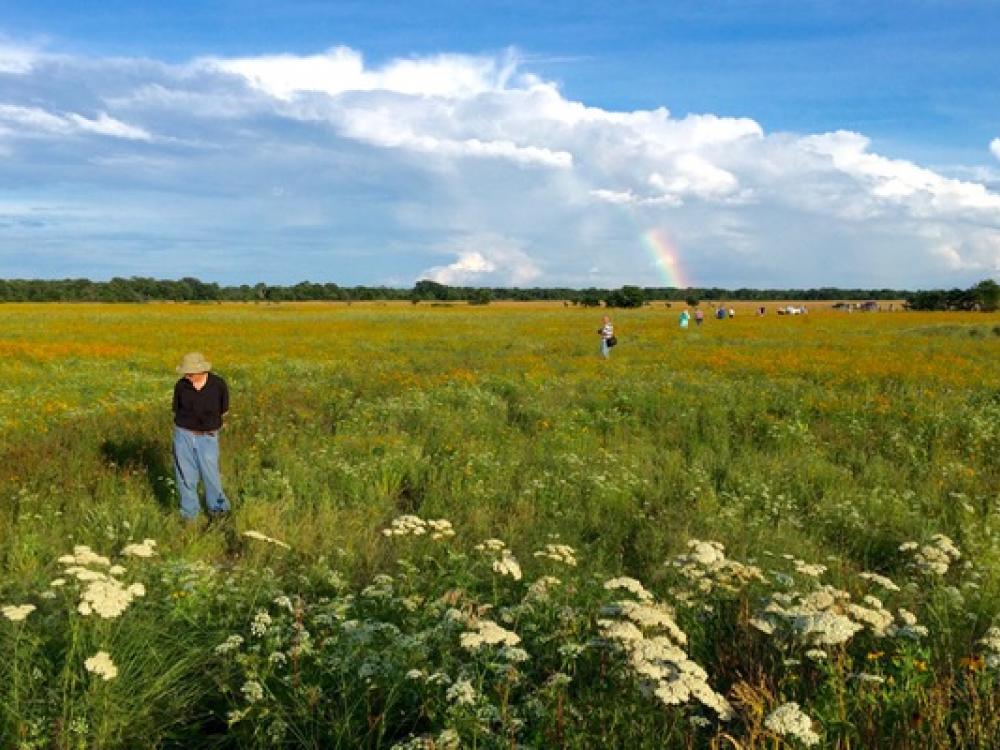
The Native Prairies Association of Texas hosted a prairie tour in Northeast Texas in early June. Intrepid Green Source DFW columnist tagged along on the day-long charter bus tour that ended with a rainbow over Daphne Prairie in Franklin County. Photo by Stalin SM.
June 28, 2016
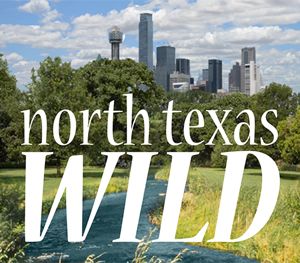 DAWN IS NO TIME TO BE ALIVE
DAWN IS NO TIME TO BE ALIVE
Saturday June 5, 7 a.m.
I’m one of the last to get on. The bus buzzes with about 50 perky people, all dressed in sensible hiking clothes. I have no idea what I’m wearing. Why are they talking? I was asleep a half-hour ago. Why am I here? Oh yeah, I agreed to this, paid money even, to Native Prairies Association of Texas for a tour of Northeast Texas prairies, most of which are only open for guided tours like this. Even so, start time at 7 am? What was I thinking? The row behind the bus driver is the only open one. I slip into the seats and wait for caffeine and consciousness to engage. I love nature, but I’m clearly not naturalist material.
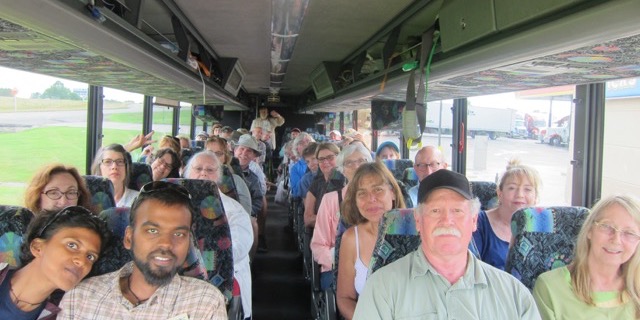 CLYMER MEADOW IN THE MORNING
CLYMER MEADOW IN THE MORNING
8:15 a.m.
The bus zips through a series of right-angle turns as it wiggles its way out of the small town of Celeste. We pick up some representatives of The Nature Conservancy, including Larry Crane and Brandon Belcher, the newly named manager of our first stop, Clymer Meadow. The driver tools along F.M. 1562, executes a steep turn and lurches onto the gravel county lane with barely missing a beat. This driver has game.
The "Prairie Pranksters" Bus Tour. Front row, Dipitha “Dodi" Dilipan, Stalin SM, Glenn Merkord, Amy Martin.
As the bus turns down the narrow lane, Belcher, and the tour’s chief naturalist, R.J. Taylor, begin regaling us with facts. On the left is the original 1,400-acre acres of Clymer Meadow, one of the largest and most diverse remnants of the Blackland Prairie, bedecked with wildflowers and festooned with full ponds. On the right is degraded prairie, newly purchased by TNC and NPAT. We learn of efforts to rehabilitate it, the burning and cutting of brush, using a seed drill to press in seeds of native species without disturbing the prairie, the constant battle against wild hogs. It’s a prairie jungle out there. With more than 3,000 pounds of foliage per acre, a tallgrass prairie produces more oxygen than most forests.
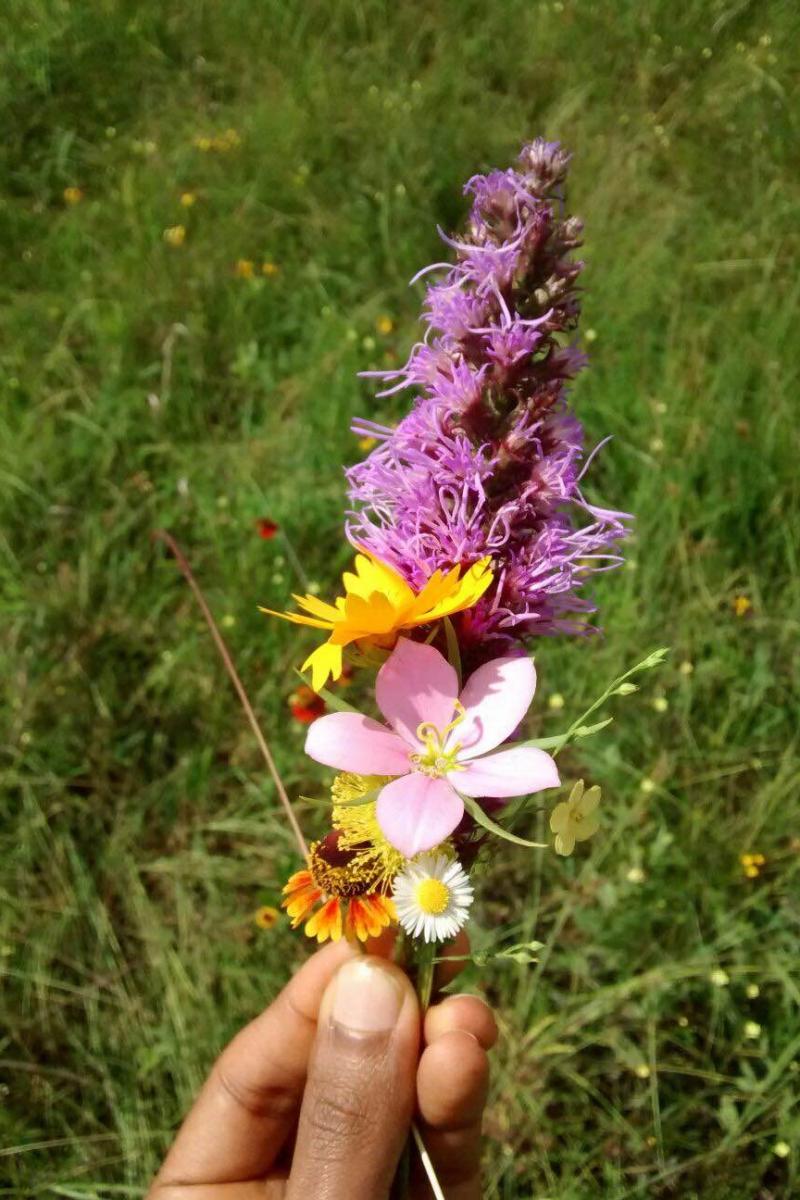 We file out at a gate onto the TNC preserve’s main road, leaving the driver, to do the impossible — make a U-turn on a country road in a bus — and come back. We prairie explorers follow Belcher and other leaders deep into the fields of big and little bluestem whose new bluish leaves emerge from last year’s strappy stubble. A few of the fall seed heads of Indiangrass (Sorghastrum nutans) and switchgrass (Panicum virgatum) extend auburn and fluffy above the new prairie growth. We stop to look at eastern gamagrass (Tripsacum dactyloides), related to teosinte, the precursor of modern corn. Sideoats grama (Bouteloua curtipendula) and Canada wildrye (Elymus canadensis) are thriving. The Blackland Prairie has always been the breadbasket. Because of that, more than 99 percent of it has been cultivated, making it the most endangered large-scale ecosystem in North America.
We file out at a gate onto the TNC preserve’s main road, leaving the driver, to do the impossible — make a U-turn on a country road in a bus — and come back. We prairie explorers follow Belcher and other leaders deep into the fields of big and little bluestem whose new bluish leaves emerge from last year’s strappy stubble. A few of the fall seed heads of Indiangrass (Sorghastrum nutans) and switchgrass (Panicum virgatum) extend auburn and fluffy above the new prairie growth. We stop to look at eastern gamagrass (Tripsacum dactyloides), related to teosinte, the precursor of modern corn. Sideoats grama (Bouteloua curtipendula) and Canada wildrye (Elymus canadensis) are thriving. The Blackland Prairie has always been the breadbasket. Because of that, more than 99 percent of it has been cultivated, making it the most endangered large-scale ecosystem in North America.
A prairie flower bouquet. Photo by Stalin SM.
Clumps of prairie aficionados begin gathering, some drawn to the tall sunflower like rosinweed (Silphium integrifolium) that towers above all else. Others search for a forb called pincushion (Scabiosa atropurpurea) with attractive purple flowers and the thin spikes of tall fescue (Schedonorus phoenix), both invasives that are creeping into Clymer. Naturalists clutch notebooks, tote cameras, kneel down in the grass and look very carefully at things. A few gravitate to what seems an incongruous sight: a beaver lodge in a prairie pond.
 The air vibrates with the calls of hundreds of hidden dickcissels and phoebes, and millions of buzzing and clicking bugs, in the unfathomably dense foliage. A painted bunting flies across our path and alights on the tall, stiff seedhead of rattlesnake master (Eryngium yuccifolium) before flying off. Binoculars rise to catch the colorful sight. Mine are on the bus, of course.
The air vibrates with the calls of hundreds of hidden dickcissels and phoebes, and millions of buzzing and clicking bugs, in the unfathomably dense foliage. A painted bunting flies across our path and alights on the tall, stiff seedhead of rattlesnake master (Eryngium yuccifolium) before flying off. Binoculars rise to catch the colorful sight. Mine are on the bus, of course.
Rattlesnake master. Courtesy of NPAT.
Clymer’s prairie has undulations and layers. Close to the ground, vines of dewberries thread between clumps of grass and swaths of shockingly fuchsia colored star-shaped flowers. About two feet high, eastern purple coneflowers (Echinacea purpurea) are wrapping up their display, lavender petals fading fast and stalks turning to seed. Brambles of pink prairie roses create airy four-foot tall mounds that birds adore. Indian plantain (Arnoglossum plantagineum) tie it all together, with broad, juicy leaves low to the ground and a stem five feet tall topped with stiff white umbrels.
Naturalist R.J. Taylor talks to prairie tourists.
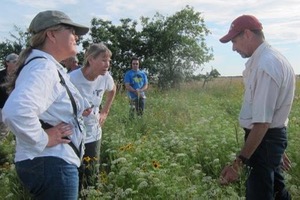 While a forest changes slowly, the prairie varies from week to week, even day to day. There is always something in season in the prairie, something bursting into flower or fading into seed. The pink pom pom buds of basketflower (Centaurea Americana) are everywhere. In a few days, they’ll unfurl into three-inch magenta blooms, loved by every bug in the world. Awesome to think that soon a thousand acres will be full buzzing red-purple flowers.
While a forest changes slowly, the prairie varies from week to week, even day to day. There is always something in season in the prairie, something bursting into flower or fading into seed. The pink pom pom buds of basketflower (Centaurea Americana) are everywhere. In a few days, they’ll unfurl into three-inch magenta blooms, loved by every bug in the world. Awesome to think that soon a thousand acres will be full buzzing red-purple flowers.
We gather on the broad crest between two wet-weather draws, which are swale-like low spots. The preserve's thousand acres unfurls from the high spot, slopes covered in splotches of pastel and bright colors, glimmers of wetlands in the low valleys between. Blue herons skim the impromptu ponds for amphibians barely visible in the thick wet grass. It startles the nesting redwing blackbirds who rise in clouds of crimson dots. In the midst of the beauty, I’m struck by the loss. Heartbreaking to think that this is it, probably the biggest piece left of the Blackland Prairie.
Belcher calls us together and speaks of the gilgai, small depressions that happen only when the land is unplowed. The clay-rich black soil dries out and develops large cracks. Things fall in, explains Belcher, “rocks, plant matter, small mammals,” that fill the crack. (Small mammals?!) When rains return, the clay soil swells and ridges form, circular on the tops of hills and linear on the sides.
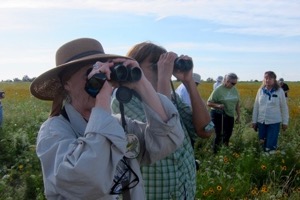 Over eons, the ridges erode and reform, and the soil essentially tills itself, earning the name vertisol, from the Latin vertere, to turn. Once a prairie is plowed, the gilgai rarely return. The next thing you know, Belcher steps from a gilgai ridge into the center with a splash. He’s a good foot shorter than he was before. Then he pops up again. His gopher imitation greatly amuses us. The gilgai will hold water that seeps out for months, nourishing the nearby plants. In six square feet, Belcher explains, there are three ecosystems: wet in the middle, dry on the ridge tops, and interim on the slopes. The intricate landscape of the prairie.
Over eons, the ridges erode and reform, and the soil essentially tills itself, earning the name vertisol, from the Latin vertere, to turn. Once a prairie is plowed, the gilgai rarely return. The next thing you know, Belcher steps from a gilgai ridge into the center with a splash. He’s a good foot shorter than he was before. Then he pops up again. His gopher imitation greatly amuses us. The gilgai will hold water that seeps out for months, nourishing the nearby plants. In six square feet, Belcher explains, there are three ecosystems: wet in the middle, dry on the ridge tops, and interim on the slopes. The intricate landscape of the prairie.
Birdwatching on the prairie.
On the walk back to the bus, I ask Belcher if managing a prairie preserve is like being the gardener of a giant plot.
“Yes, absolutely. We’re always thinking about the next project while were working on this one, just like a farmer working with cycles.”
It’s not unlike how Native Americans managed the prairie, he says.
“They knew that if you burn prairie in the fall, it will be more fertile in the spring. The higher protein content of the new plants, which so important for the young, attracts animals, so the hunting is good. They also burned the prairie behind them if they were pursued.”
“Of course, we do it to improve the soil and keep brush from taking over,” says Belcher. “It’s a never-ending battle. Without buffalo and wildfires, invasive woody plants can take over a prairie in three years.”
He says this as we pass a wet-weather draw and its tangle of brushy cedar elm and hackberry, ever creeping out into the grasslands. As a prairie manager, Belcher is the buffalo, a buffalo with a chainsaw.
"The prairie remnants of north central Texas are islands in a sea of injured land. Land talks to us. In those places where process and diversity are intact, they emit a sense of health, a sense of wholeness. When you step into an old cottonfield, you can feel its broken-ness. Whole land has a whole heart. Broken land has a broken heart.” - Jim Eidsen, former manager of Clymer Meadow
A ROLLING BLADDER INSURRECTION
10 a.m.
By this point, it’s clear: the bus bathroom flushes no more. No amount of lever giggling brings it back to life. Fifty people on a bus with no bathroom. Mass quantities of coffee ingested before leaving. It’s not that the roads are bumpy. It’s all the jiggling legs on the bus. You can almost see the rising fluid levels in people’s eyes. Even the bus driver seems to be sitting on the edge of his chair. The prairie is lovely, but it provides few hidden places to pee. Pat Merkord, the executive director of NPAT, takes the seat next to me.
Fortunately, only a few miles ahead lies the town of Leonard with the holy triumvirate that constitutes rural downtown in this modern age: Sonic, Dairy Queen and KwikCheck gas station and store. The bladder-anxious bus patrons disembark, but Merkord, being a Southern hostess of good graces, stays to exchange pleasantries with the travelers as they do. My bladder muscles clench so tight they can crack a walnut.
As I (finally!) approach the KwikCheck, I see Kim Conrow, her niece Corinna Benson and two other gals sprinting my way.
“We’re headed to the DQ. We can’t wait that long,” says Conrow of lines inside the station.
We race across the highway, knock-kneed and bearing down all the all the way. DQ bathrooms are for paying customers only, but no employee stops this wild-eyed gang as we commandeer the bathroom. One of the gals, being a sweetheart, buys a Blizzard on the way out to pay for our sweet, sweet relief.
PASTURES VS PRAIRIES –TRIDENS PRAIRIE & SMILEY WOODFIN PRAIRIE
10:25 am
The bus of 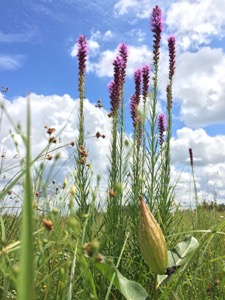 prairie pranksters is now in a much better mood and amped on Ann Sansome’s “buffalo chip” cookies (not made with the titular ingredient, thank goodness). We hurtle down U.S. 82, passing endless uniform and monotonous hay fields of Bermuda and Johnson grass. Plenty of grazing cattle on pastures past their prime and the occasional field of sorghum. Many people think that’s what prairie is. Hardly. It’s more like suburbia on a huge scale with cows instead of dogs.
prairie pranksters is now in a much better mood and amped on Ann Sansome’s “buffalo chip” cookies (not made with the titular ingredient, thank goodness). We hurtle down U.S. 82, passing endless uniform and monotonous hay fields of Bermuda and Johnson grass. Plenty of grazing cattle on pastures past their prime and the occasional field of sorghum. Many people think that’s what prairie is. Hardly. It’s more like suburbia on a huge scale with cows instead of dogs.
Gayfeather and milkweed.
As we approach the city of Paris, Merkord and Taylor gather our attention. To the south is Tridens Prairie, nearly 100 acres dominated by two rare prairie grasses, long-spiked tridens (Tridens strictus) and silveanus dropseed (Sporobolus silveanus). It looks much as it did in 1841 when Zacharia Westfall took possession, as if a watercolorist splattered it with a bright pink, yellow and orange against a backdrop of varied grays and greens. More than 150 species of native grasses and wildflowers flourish here, a far cry from the monocultures that now dominate the rural landscape. But there is no place to park the bus, even with our savvy driver at the helm.
Instead, we turn north on S.H. 38, alongside a vast field that looks much like Tridens, but lacks the wildflowers. It’s Smiley Woodfin Prairie, the largest producer of native hay in the state, featuring tridens and silveanus dropseed. It’s tamed, as prairies go, but never plowed, so the original soil and root ecosystem is intact. Three-foot tall, unmowed tufts punctuate the landscape. Prairie nerds press their faces to the windows, thrilled to set eyes on mima or pimple mounds, another prairie phenomenon like gilgai and possible only on unplowed land.
“Prairies are productive beyond imagining, some producing 7,000 pounds of herbage per acre without fertilizer. The potential exists to model row crop agriculture on prairie — without pesticide and herbicides; without irrigation; and possibly without annual tillage.” - Jim Eidsen
TOTO, WE’RE NOT IN BLACKLAND ANYMORE - GAMBILL GOOSE PRESERVE
11:30 a.m.
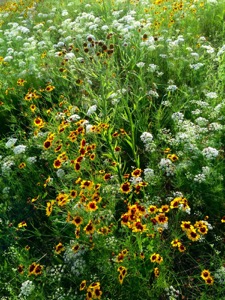 It’s a goose-free day at the 600-acre Gambill Goose Preserve, the usual inhabitants currently off to their summer breeding grounds. We are on the other side of a small lake from Gambill, in a modest unnamed city park that happens to contain an original prairie remnant. The city of Paris, much to its credit, is preserving it as a complement to the preserve.
It’s a goose-free day at the 600-acre Gambill Goose Preserve, the usual inhabitants currently off to their summer breeding grounds. We are on the other side of a small lake from Gambill, in a modest unnamed city park that happens to contain an original prairie remnant. The city of Paris, much to its credit, is preserving it as a complement to the preserve.
Prairie bishop and greenthread.
But this is not your father’s tallgrass Blackland Prairie. With Tridens and Smiley Woodfin, we’ve shifted into quieter prairies that flourish on alfisol soils, ones that are sandier and more acidic. The top soil is not as thick and plants tend to be shorter. Unlike the giants of the tallgrass prairies — big bluestem (Andropogon gerardii), eastern gamagrass, Indiangrass and switchgrass — which can tower at over six feet, little bluestem (Schizachyrium scoparium), tridens and silveanus dropseed are barely two feet, with narrow strappy leaves less than a quarter inch across. Unlike at Clymer, here the modest white umbrels of prairie bishop (Bifora Americana) are easily seen, as are the small yellow blooms, red centers and dark green narrow leaves of greenthread (Thelesperma filifolium). Looking like a fairy cabana, a lovely delicate, sensitive briar (Mimosa microphylla) sends out splays of miniature mimosa-like leaves and light fuchsia poms.
The park is redolent in birdsong, with lark sparrows and dickcissels perched on the tall stems of yellow flowering rosinweed, declaring territories. Barn swallows and purple martins work the gnat and mosquito clouds over the lake. Naturalists thrill at the first appearance of giant coneflower (Rudbeckia maxima), which soars six feet to the sky with its bulging dark cone-shaped center and elegant double ring of yellow petals. The prairie travelers spread out with cameras and notebooks, newbies gathering around Taylor and advanced naturalist Tim Dalby to try and absorb maximum knowledge.
I’m in it for the hiking and take off to see where an old road will take me, hoping that rumors of a large giant coneflower patch will reward all the dodging of mud puddles and poison ivy. It’s a longer walk than I thought and my bladder increasingly sings the song of its people. A curve in the road beckons a private wooded area for a necessaries visit, but around the bend is both coneflowers and a naturalist ogling them. So I do an evil thing: I state loudly that Merkord is calling us back to the bus and he heads off. By the time he realizes he’s been had, I’m already loping back down the road. We pass and I offer an embarrassed grimace. He grins and understands.
“I was born upon the prairie, where the wind blew free, and there was nothing to break the light of the sun. I was born where there were no enclosures, and where everything drew a free breath.” - Ten Bears, Comanche elder
INTERVIEW ON WHEELS
1 p.m.
We roll into the Subway shop on the U.S. 82/271 loop around Paris. This time I’m able to smile along with Merkord as the hungry and bladder-anxious crew disembarks. Back in the bus, tuna sandwich and Sunchips in hand, I enjoy lunch. With Merkord seated next to me, I have a captive interview subject. We have 90 minutes on our hands as we travel to New Boston, nearly to the Louisiana border. What’s she going to do?
A few excerpts from our conversation:
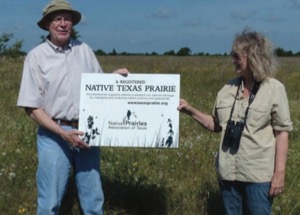 Merkord: “Huge concern right now on the loss of our pollinators who are responsible for over 70 percent of our food that we eat. The best habitats for pollinators are native prairies, and the species that occur on them are the best for pollinating crops. It impacts us economically in a very big way.”
Merkord: “Huge concern right now on the loss of our pollinators who are responsible for over 70 percent of our food that we eat. The best habitats for pollinators are native prairies, and the species that occur on them are the best for pollinating crops. It impacts us economically in a very big way.”
Landowner BF Hicks accepts a sign for Daphne Prairie from Pat Merkord, executive director of the Native Prairies Association of Texas, in June 2015. Photo courtesy of NPAT.
There is a direct correlation, says Merkord, between the decline of pollinators and the decline of native prairies, both now at a crisis point. With only 1 percent of the prairie remaining, I mention it may seem futile to try preserving them.
Merkord: “There are many types of wildlife that will disappear if we give up on prairies. We lose what was once half of the United States; we won’t even know what it looked like. The prairie is our history; it’s what this country was made from.”
We pondered why it is people that get emotional about trees and demand preservation of significant forests, but treat grasslands as if expendable.
Merkord: “It’s because they’ve never seen them. Most people when I take them to a prairie for the first time are very impressed. Everything that they think is prairie is just invasive grasses imported for forage. It doesn’t have the beauty the texture, the color, of a native prairie.”
She invoked that legend of roadside Texas wildflowers, Lady Bird Johnson, the wife of President Lyndon Baines Johnson.
Merkord: Lady Bird Johnson recognized that one of Texas’ greatest treasures are its wildflowers. And where do they grow? The prairies! But you need to see them at something other than 75 mph."
We talk of how our cold dismissal of prairies is all tied up with human tendency to downplay how youth shapes us. History is a hard concept for many.
Merkord: "Those prairie soils are what became our breadbasket. The prairies are what built Texas and our country. We had to have food farms and ranches, and it was prairie land that was used because it was the best soil and easiest to farm."
The ongoing press for oil drilling and fracking is destroying more prairies, she says. Heavy equipment and bulldozing to create extensive road systems and retaining ponds for toxic fluids plunder delicate prairies.
Merkord: “We have used and used and used prairies. It’s time to give back. It’s literally what made us who we are. To have no respect for that when it’s given so much doesn’t seem fair. Which is why Native Prairies Association of Texas has such a vigorous education outreach. The best way to do that is to have trips like this to get people out into prairies."
As we look out the bus window onto endless pastures, it’s stunning to think that settlers plowed nearly every open acre in northeast Texas. Each of those farmers was convinced to plant imported forage promoted by seed companies. Some horse and dairy cattle ranchers knew native grasses are more nutritious and never plowed, which is how many prairies remain preserved, though not always in good condition.
Merkord: “The future lies in restoring degraded prairies. There will be no new remnants of prairies. But there’s is a lot of interest from ranches in planting native prairie grasses because nonnatives like Bermuda need a lot of water and fertilizer which is going up in cost.”
“There seemed to be nothing to see; no fences, no creeks or trees, no hills or fields. If there was a road, I could not make it out in the faint starlight. There was nothing but land: not a country at all, but the material out of which countries are made.” - Willa Cather, My Ántonia
PRAIRIE AS FAMILY LEGACY – MARY TALBOT PRAIRIE
3 p.m.
Being seated directly behind the bus driver has advantages, like seeing the shocked expressions on people’s faces as a giant bus comes barreling down their little rural road. Now almost to the Louisiana border, we turn south off I-30 at New Boston in Bowie County and venture into the sandy countryside. We stop in front of a field, sandwiched between two modest rural parcels of clapboard homes and pastures. Ready to stretch after that long ride, patrons bolt off the bus.
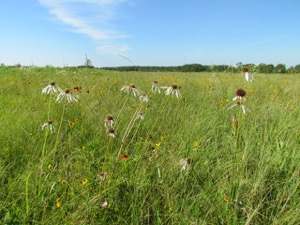 We stride out into Mary Talbot Prairie, once called Godley Prairie for a nearby church. Lloyd Wilson encouraged his grandson, David Talbot to leave the prairie as it was. The 115 acres is cut for hay to feed their livestock, but never grazed or plowed. Talbot passed ownership to NPAT in honor of his mother and grandfather, with help from Nature Conservancy of Texas, Native Plant Society of Texas and private donations.
We stride out into Mary Talbot Prairie, once called Godley Prairie for a nearby church. Lloyd Wilson encouraged his grandson, David Talbot to leave the prairie as it was. The 115 acres is cut for hay to feed their livestock, but never grazed or plowed. Talbot passed ownership to NPAT in honor of his mother and grandfather, with help from Nature Conservancy of Texas, Native Plant Society of Texas and private donations.
Coneflowers on Mary Talbot Prairie. Courtesy of NPAT.
Much like at Paris, the silver-green tridens and silveanus dropseed dominate, dotted with the modest blue-teal clumps of little bluestem and switchgrass. The higher rain amounts here result in a lush density of grasses and wildflowers, sustaining more than 300 plant species. Naturalists squeal with delight to see giant coneflower so abundant. Greenthread is everywhere and hearty, and the sensitive briar has yellow pom poms instead of purple, sending naturalists deep into botany books.
Mary Talbot Prairie has a gentle beauty as if a watercolorist gave each species its unique splash of hue. The random patterns shift with the wind. The prairie invites you in, asks you to open yourself to the sky, to not be afraid to wander and make your own trails. As the naturalists ooh and ahh over some rare plants, I head another direction. What is that shaggy tuft of taller grass over there, I wonder? A mima mound soon reveals. I rush over and scale it.
It’s so clear why the Native Americans found these and other mounds to be compelling. In this flat land, even a three-foot elevation like this creates a shockingly new view. You are above the land, yet merged with it, in harmony. The mound reaches to the sky and brings the epic landscape of clouds and shifting light down to the earth. Below, roots of prairie grasses penetrate yards into the dark soil. The mound unites the three levels of indigenous cosmology: Upper, middle and lower worlds. How fitting to see the prairie flush with tall compass plant (Silphium laciniatum) whose big yellow flowers track the Sun’s daily east to west passage. The native plant is considered an indicator species, promising a prairie of good health.
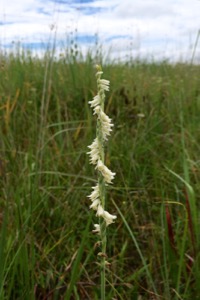 Sunlight wavers in the late afternoon. Bobwhite quail and meadowlark champion their territories with song. My scaling the mima has attracted others. We exchange observations and chigger advice in passing. An East Indian native, who goes by the easily prounouncable name of Stalin SM for short, shows me a stem with small white blooms descending in a spiral. Leaving the mound, I notice a group of blue false indigo (Baptisia australis), with pale grey-green leaves and violet pea-like flowers on intoxicating spires. The further you walk into a prairie, the more it opens your eyes.
Sunlight wavers in the late afternoon. Bobwhite quail and meadowlark champion their territories with song. My scaling the mima has attracted others. We exchange observations and chigger advice in passing. An East Indian native, who goes by the easily prounouncable name of Stalin SM for short, shows me a stem with small white blooms descending in a spiral. Leaving the mound, I notice a group of blue false indigo (Baptisia australis), with pale grey-green leaves and violet pea-like flowers on intoxicating spires. The further you walk into a prairie, the more it opens your eyes.
Twisted orchid at Clymer Meadow.
As I looked about me I felt that the grass was the country, as the water is the sea. The red of the grass made all the great prairie the color of winestains, or of certain seaweeds when they are first washed up. And there was so much motion in it; the whole country seemed, somehow, to be running.” - Willa Cather, My Ántonia
GOOGLE MAPS RULES
5 p.m.
Glenn Merkord takes the seat next to me, switching with his wife Pat who takes off to help ready things at our final stop, the renowned Daphne Prairie. We tarried in the prairies and are running over an hour behind. Navigation freaks who follow the tour in Google Maps sound an alarm; Pat calls about the same time. Ahead, I-30 westbound is nearly shut down. Through it looks clear just ahead, we prompt the driver to take the next exit and head down the frontage road.
As we crest a hill, we see the red taillights of stopped cars. Bus patrons cheer as we pass at highway speed. We take yet another bathroom pit stop at a convenience store and head north on S.H. 37. B.F. Hicks, the prairie’s owner, has promised us a sunset hayride and catered dinner at his renovated historic church turned B&B in Mount Vernon. We are salivating. The sandwiches from Subway seem so very long ago, and the buffalo-chip cookies are all gone.
AT RAINBOW’S END – DAPHNE PRAIRIE
6:30 p.m.
The bus driver nimbly navigates yet one more narrow country road. Hicks and his crew greet us at the gate, along with some locals who’ve picked up the prairie passion from Hicks. Two drive huge pickups that tow 16-foot trailers, one stacked with hay bales for seating and the other with benches. We pile on in delight. It’s the Cadillac of hayrides.
Hicks, a lawyer in nearby Mount Vernon, is the captain of this party, and the 922 acres of Daphne Prairie has been in his Franklin County family since the 1850s. The original prairie of tridens and silveanus dropseed, never plowed or disturbed, is nearly as large as Clymer and just as important for preserving prairie plant diversity. But once the property was split up and passed on by his parents, only B.F. felt passion for the prairie. Determined to restore a family heritage, he persisted with many years of negotiations with siblings and others to purchase the acreage he wanted.
The landscape is flat, with little roll, crossed by old fencelines still marked by trees. Folks laugh as our hayride jiggles and winds among the prairie parcels, splashing through water from recent rain in draws and low spots. Occasionally the trailers stop and crew members fill us in on conservation activities at Daphne that garnered Hicks the Lone Star Land Steward Award from Texas Parks and Wildlife in 2013. To ensure his legacy continues, Hicks assigned Native Prairies Association of Texas a conservation deed on the land. It’s an intensely significant conservation effort, preserving the history of both land and family, woven as one.
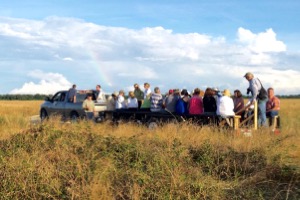 At last, the hayride comes to a halt in what seems to be the center of Daphne. There are no neighboring plots to see, not an indication of civilization anywhere. This is inner Daphne, its crown jewel — 88 acres that was never grazed and cut for hay only once a year on July 4th as a part of family festivities. So pristine in its biodiversity, boasting nearly 400 species, that Nature Conservancy biologists spent just one afternoon there and added dozens more species. Just yards away, in the area that was grazed and hayed, smaller delicate forbs are not seen.
At last, the hayride comes to a halt in what seems to be the center of Daphne. There are no neighboring plots to see, not an indication of civilization anywhere. This is inner Daphne, its crown jewel — 88 acres that was never grazed and cut for hay only once a year on July 4th as a part of family festivities. So pristine in its biodiversity, boasting nearly 400 species, that Nature Conservancy biologists spent just one afternoon there and added dozens more species. Just yards away, in the area that was grazed and hayed, smaller delicate forbs are not seen.
Prairie nerds bound off the trailers. “Look at those mima mounds!” several exclaim at once. So many mounds, every 20 yards or so. They are genuinely overwhelmed, like kids faced with a 100-count box of chocolates. Unlike others we’ve seen, these mounds are nearly twice tall at five to six feet. It shows how cattle grazing done without care can decimate a landscape. Squatting down to gaze over the prairie at its level, the mima look like little green volcanoes with colorful wildflower lava flows. Butterflies and bees are everywhere.
For a medium-grass prairie, the inner Daphne is astoundingly thick. Yet less than a year ago, Hicks and his crew completed a controlled burn on it, incinerating all the foliage. Fascinating to hear what seems like Texas country boys talking about Daphne's beauty and restorative quiet, how the prairie has a different color palette from week to week. One remarks that Daphne creates more good on its own than a cultivated field ever could and how that makes most men jealous. Prairie metaphors run deep.
“We come and go, but the land is always here. And the people who love it and understand it are the people who own it – for a little while.” - Willa Cather, O Pioneers!
Daphne’s fertility is stupendous. At the two prior prairies, we saw terrific rattlesnake master specimens. Here there are entire patches of them, spikey yucca leaves and tall stiff flower stems topped with white globular thistle-like flowers. All that angularity surrounded at the base by airy sensitive briar — the gentle toughness of the prairie encapsulated. Vast patches of giant coneflower and compass plant try to out compete each other for whose shade of yellow is most beloved by the Sun.
The peace of Daphne sweeps up from underneath you. It stills you, reminds you that your sole job in this life is to pay attention. To stand on a mima mound and feel how the prairie wind is full of energy and made from a myriad of micro air currents fused into one. To inhale the aroma of green living things — so different from the decay and mold of forests. You notice how feet never touch ground in the prairie, but tread upon a weave of fallen leaves that softens upon touch like a pillow.
There is a sense of the sacred at Daphne. An ocean of grass spreads horizon to horizon, and the sky reminds that there is nothing between us and the infinite except our misplaced faith in gravity. I am of this land, this Texas land, bones forged from crops sprung from its soil, raised on milk from cows that grazed its fields. I breathe air that emits from its plants and drink water of its reservoirs. It is my body to its very bones. Daphne strips me of hubris, forces the perspective of time with such clarity I start to cry. This is history, built from roots and leaves, minerals and water, a witness to all man’s doings that came long before us and will continue ever on. The land holds memory, weeping and laughing as required. And as its daughter, I join along.
The mima mounds cast long shadows. Hicks wrangles the prairie troupers. Small groups stake out various mima mounds, enraptured with their own experiences and reluctant to stop. Hicks persists, does a quick head count and inquires about the missing. We discover they struck out for a closer look at inner Daphne’s lone tree, which he knows is much further away than it appears. He sends one of his younger crew members to lope out after them. As we begin to head back to the hayride trailers, a rainbow arises in the west against the receding storm clouds, with Daphne the prairie pot of gold at its end.
The prairie skies can always make you see more than what you believe.” - Jackson Burnett, The Past Never Ends
SANCTIFIED BARBEQUE & BACK TO DALLAS
8:30 p.m.
Having oneness experiences with the universe stirs a mighty hunger. Hicks hustles us back to the bus and on to the nearby town of Mount Vernon. Impassioned about history in all its forms, he renovated a 1924 Methodist church and turned it into a B&B and event hall rather than see it torn down. The old sanctuary hosts tables of barbeque and salads, cold wine and beer and fanciful cakes from the local baker, plus plenty of pews to sit in.
But it’s hard to stay seated. Against the walls are display cases of antique books and decorative notions, arrowheads a plenty and ancient Native American pottery. The collection is at once both whimsical and methodical, so very much like its curator. What is this tall, well-locked wooden piece about the size of a phone booth? It’s a gun closet, says Hicks, “But I keep a skeleton in it.”
Exhausted and well fed, we pile on the bus. The church ladies pack the bus driver up with plenty of food to go. It’s nearly two hours to Dallas. We are a motley crew, rather dirty and wet, tired and happy. Those who’d been only curious about the prairie before are genuine grass nerds now. Even Stalin’s friend, all the way from India, Dipitha Dilipan, who we call Dodi. The bus tour forged at least a dozen new converts to preach the prairie gospel, ready to share with others its living chapel of grass, flower, sky and infinite time.
“This country was mostly wild pasture and as naked as the back of your hand… so the country and I had it out together and by the end of the first autumn, that shaggy grass country had gripped me with a passion I have never been able to shake.” - Willa Cather
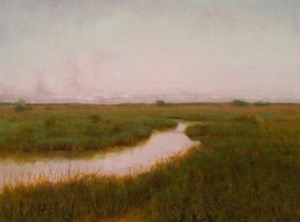 The Nature of Things - Daphne Prairie
The Nature of Things - Daphne Prairie
What: An exhibit of oil paintings and drawings by Deborah Paris featuring Daphne Prairie
When: Sept. 10-Oct. 10
Where: The Botanical Research Institute of Texas, 1700 University Dr. Fort Worth.
Sign up for the weekly Green Source DFW Newsletter to stay up to date on everything green in North Texas, the latest news and events. Follow us on Facebook, Twitter and Pinterest.









